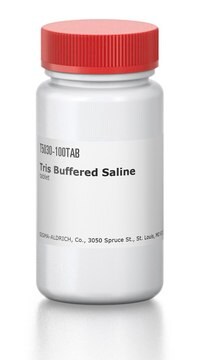480012
NDSB Set
Contains the following non-detergent sulfobetaines: 5 g of NDSB-195, 25 g of NDSB-201, and 5 g of NDSB-256.
Zaloguj sięWyświetlanie cen organizacyjnych i kontraktowych
About This Item
Kod UNSPSC:
12352200
NACRES:
NA.21
Polecane produkty
Poziom jakości
Formularz
solid
producent / nazwa handlowa
Calbiochem®
warunki przechowywania
OK to freeze
desiccated (hygroscopic)
rozpuszczalność
water: 50 mg/mL
Warunki transportu
ambient
temp. przechowywania
15-25°C
Opis ogólny
Contains the following non-detergent sulfobetaines: 5 g of NDSB-195 (Cat. No. 480001), 25 g of NDSB-201 (Cat. No. 480005), and 5 g of NDSB-256 (Cat. No. 480010). Supplied with a data sheet.
Non-detergent sulfobetaines (NDSBs) are zwitterionic compounds. Like zwittergents (zwitterionic detergents), NDSBs carry the sulfobetaine hydrophilic head group. However, unlike zwittergents, the hydrophobic group in NDSBs is too short for micellar formation even at concentrations as high as 1M. Hence, NDSBs do not behave like detergents. Because of their zwitterionic nature, NDSBs were first employed to neutralize electrostatic interactions without increasing the conductivity in native isoelectrofocusing gels. Recently they have found utility in various other applications including isolation of membrane proteins, purification of nuclear proteins and halophilic proteins, renaturation of chemically and thermally denatured proteins and protein crystallization. They are potentially useful in solubilization and renaturation of fusion proteins from inclusion bodies. It is hypothesized that the hydrophobic group, although short, interacts with the hydrophobic regions of the protein preventing aggregation during renaturation. Also, presumably, the contribution from the short hydrophobic groups combined with charge neutralization ability of the sulfobetaine group results in higher yields of membrane proteins.
NDSBs do not interfere with enzymatic assays based on chromogenic substrates bearing nitrophenyl groups and do not inhibit the activities of β-galactosidase and alkaline phosphatase, the two enzymes tested thus far. NDSB-195 has the added advantage in that it does not absorb at 280 nm, making it compatible with protein purification procedures in which the protein concentrations are determined by absorbance measurements at 280 nm. Supplied with a data sheet.
NDSBs do not interfere with enzymatic assays based on chromogenic substrates bearing nitrophenyl groups and do not inhibit the activities of β-galactosidase and alkaline phosphatase, the two enzymes tested thus far. NDSB-195 has the added advantage in that it does not absorb at 280 nm, making it compatible with protein purification procedures in which the protein concentrations are determined by absorbance measurements at 280 nm. Supplied with a data sheet.
Ostrzeżenie
Toxicity: Irritant (B)
Rekonstytucja
Store lyophilized products at room temperature. Following reconstitution, store in the refrigerator (4°C) or at room temperature (20°C).
Inne uwagi
Goldberg, M.E., et al. 1996. Folding and Design1, 21.
Goldberg, M.E., et al. 1995. Folding & Design1, 21.
Vuillard, L., et al. 1995. Biochem. J.305, 337.
Vuillard, L., et al. 1995. Anal. Biochem.230, 290.
Vuillard, L., et al. 1994. FEBS Lett.353, 294.
Goldberg, M.E., et al. 1995. Folding & Design1, 21.
Vuillard, L., et al. 1995. Biochem. J.305, 337.
Vuillard, L., et al. 1995. Anal. Biochem.230, 290.
Vuillard, L., et al. 1994. FEBS Lett.353, 294.
Informacje prawne
CALBIOCHEM is a registered trademark of Merck KGaA, Darmstadt, Germany
Ta strona może zawierać tekst przetłumaczony maszynowo.
Kod klasy składowania
11 - Combustible Solids
Certyfikaty analizy (CoA)
Poszukaj Certyfikaty analizy (CoA), wpisując numer partii/serii produktów. Numery serii i partii można znaleźć na etykiecie produktu po słowach „seria” lub „partia”.
Masz już ten produkt?
Dokumenty związane z niedawno zakupionymi produktami zostały zamieszczone w Bibliotece dokumentów.
Nasz zespół naukowców ma doświadczenie we wszystkich obszarach badań, w tym w naukach przyrodniczych, materiałoznawstwie, syntezie chemicznej, chromatografii, analityce i wielu innych dziedzinach.
Skontaktuj się z zespołem ds. pomocy technicznej







